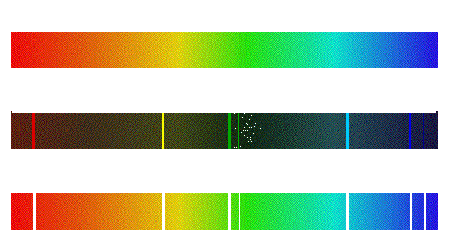
Greater the density of a star, the broader its absorption lines become.UV-Visible Spectroscopy Visible and Ultraviolet SpectroscopyĪn obvious difference between certain compounds is their color. The combined effect of these changes results in broader absorption lines. When the energy state decreases, the absorption line becomes longer in wavelength (less energy). When the energy state of an orbit increases, the absorption line becomes shorter in wavelength (more energy). These collisions result in electrostatic interaction between orbits of different atoms, leading to changes in the energy level of affect orbits. In higher density stars, the increased gas pressure produces more rapid collision between atoms. Width of absorption spectral lines also reveal information about the density of stars.ĭensity and pressure, at the surface of a star can also broaden spectral lines, but the intensity varies across the line in different way from the effect of rotation. The combined effect of these three phenomena results in broadened absorption lines in the stellar spectra. Wave emitted from the ‘middle’ of a start (region that has no relative rotation to an observer on Earth) has no change in wavelength.Wave emitted from the side of a star that is rotating away from us has longer wavelength (red-shifted).Wave emitted from the side of a star that is rotating towards us has shorter wavelength (blue-shifted).This effect can also be used to determine the rotational motion of stars. When stars move towards us, spectral lines of certain elements would be shifted towards shorter wavelengths (blue-shift) compared with a reference.hydrogen would be shifted towards longer wavelengths (red-shift) compared with a reference. When stars move away from us, spectral lines of certain elements e.g.The shifting effect is apparent when stellar spectra are compared with absorption spectra obtained by exciting elements on Earth.

The movement of stars, whether towards or away from Earth, is demonstrated by red and blue shift effects in their spectra. The following three spectra are for a hydrogen atom. Red and blue shifts observed in stellar spectra are caused by the Doppler’s Effect.

Stars with shorter peak wavelengths have higher surface temperatures. Wien’s displacement law quantitatively describes this relationship: We can use this information to compare the relative surface temperature between stars. The peak wavelength refers to the wavelength with the highest intensity. Each wavelength of radiation has a different intensity. The spectra of stars consist of a wide range of wavelengths. This is referred to as the absorption spectrum or stellar spectrum.

Instead of seeing a continuous spectrum, the stellar spectra of the Sun contain absent wavelengths (absorption lines) within the spectrum. For example, the Sun emits white light that can be captured and observed on a spectrometer. Stars emit radiation which includes visible light (400-700 nm).


 0 kommentar(er)
0 kommentar(er)
